Kedarnath Awaits Your Visit
Learn MoreWelcome To Kedarnath – The Sacred Jyotirlinga of Lord Shiva
Kedarnath, nestled in the Garhwal Himalayas of Uttarakhand, is one of the holiest Hindu pilgrimage sites and a key part of the Char Dham Yatra. Home to the revered Kedarnath Temple, dedicated to Lord Shiva, this sacred town is located at an altitude of 3,583 meters (11,755 feet), surrounded by snow-capped peaks and the Mandakini River. It is believed that the temple was originally built by the Pandavas and later reconstructed by Adi Shankaracharya in the 8th century. Kedarnath is not just a spiritual center but also an awe-inspiring destination for trekkers and nature lovers. The 16 km trek from Gaurikund offers breathtaking views of glaciers, waterfalls, and the mighty Himalayas. The town remains open from April/May (Akshaya Tritiya) to November (Diwali), after which the idol of Lord Kedarnath is shifted to Ukhimath for winter worship. A journey to Kedarnath is considered a path to moksha (liberation), making it a must-visit for devotees and travelers alike.
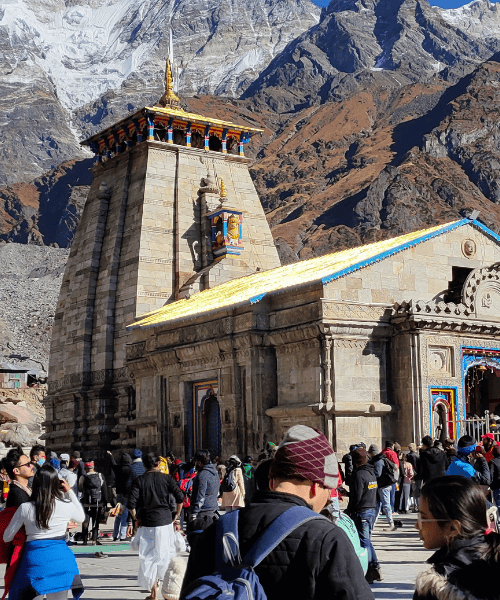
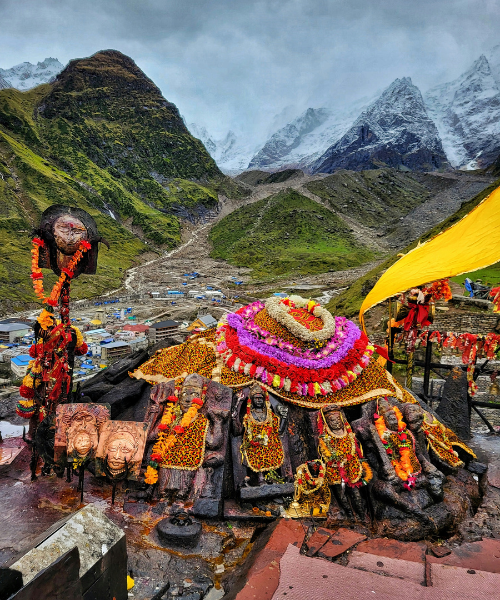
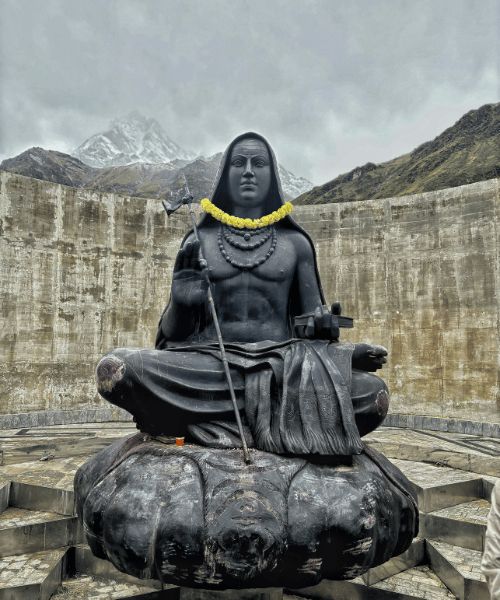
Sub Destination
Ratus Kund – The Hidden Sacred Pond
Ratus Kund is a hidden sacred pond near Kedarnath, known for its crystal-clear waters and tranquil surroundings. Pilgrims believe that taking a dip in this holy water purifies the soul. The site remains less explored, making it an ideal spot for those seeking spiritual peace away from the crowds.

Gaurikund – The Base of Kedarnath Trek
Gaurikund, located 16 km from Kedarnath, is the starting point of the Kedarnath trek. It is believed to be the place where Goddess Parvati meditated to win Lord Shiva’s love. The town is famous for its hot water springs and Gauri Temple, making it an essential stop for pilgrims before their ascent to Kedarnath.
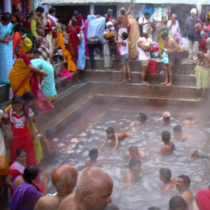



Bhairavnath Temple – The Guardian Deity of Kedarnath
Situated on a hill just behind Kedarnath Temple, the Bhairavnath Temple is dedicated to Bhairav Nath, a fierce manifestation of Lord Shiva. It is believed that Bhairav Nath protects Kedarnath when the temple remains closed in winter. The temple also offers panoramic views of the Himalayan ranges and the Mandakini Valley.
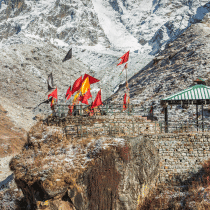



Vasuki Tal – The Pristine Glacial Lake
Vasuki Tal, 8 km from Kedarnath, is a stunning high-altitude glacial lake at 4,150 meters. The trek to Vasuki Tal offers breathtaking views of the Chaukhamba peaks and is a popular destination for trekkers and adventure seekers. The lake is considered sacred, as it is believed that Lord Vishnu bathed here.
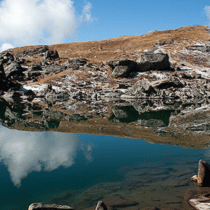



Shankaracharya Samadhi – The Final Resting Place of Adi Shankaracharya
Behind the Kedarnath Temple lies the samadhi (tomb) of Adi Shankaracharya, the great Hindu saint who revived Hinduism and established the Char Dham Yatra. It is believed that he attained nirvana (liberation) here at the young age of 32.
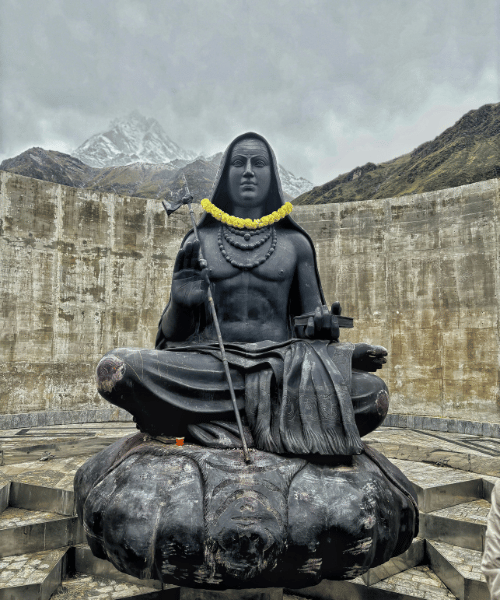
Triyuginarayan Temple – The Wedding Place of Lord Shiva & Parvati
Located 25 km from Kedarnath, Triyuginarayan Temple is where Lord Shiva and Goddess Parvati’s divine marriage took place. A sacred fire, believed to have been burning since their wedding, still exists at the temple. It is a must-visit destination for devotees and newlywed couples.
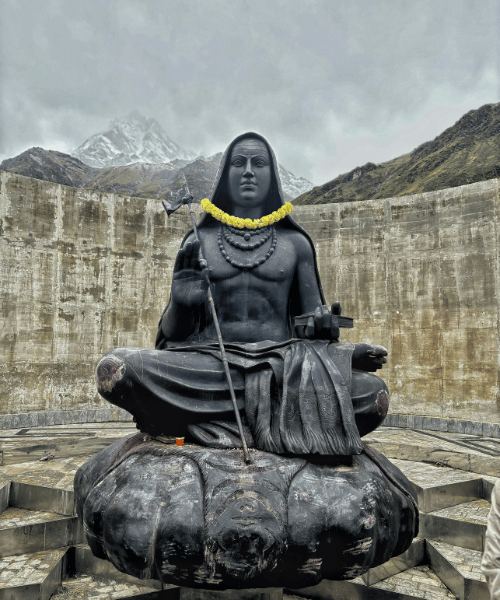
Chorabari Tal (Gandhi Sarovar) – A Crystal-Clear Lake
Situated 3 km from Kedarnath, Chorabari Tal, also known as Gandhi Sarovar, is a serene glacial lake. It is believed that Mahatma Gandhi’s ashes were immersed here, and the lake offers a peaceful retreat amidst the mountains.

Ratus Kund – The Hidden Sacred Pond
Ratus Kund is a hidden sacred pond near Kedarnath, known for its crystal-clear waters and tranquil surroundings. Pilgrims believe that taking a dip in this holy water purifies the soul. The site remains less explored, making it an ideal spot for those seeking spiritual peace away from the crowds.

Gaurikund – The Base of Kedarnath Trek
Gaurikund, located 16 km from Kedarnath, is the starting point of the Kedarnath trek. It is believed to be the place where Goddess Parvati meditated to win Lord Shiva’s love. The town is famous for its hot water springs and Gauri Temple, making it an essential stop for pilgrims before their ascent to Kedarnath.




Bhairavnath Temple – The Guardian Deity of Kedarnath
Situated on a hill just behind Kedarnath Temple, the Bhairavnath Temple is dedicated to Bhairav Nath, a fierce manifestation of Lord Shiva. It is believed that Bhairav Nath protects Kedarnath when the temple remains closed in winter. The temple also offers panoramic views of the Himalayan ranges and the Mandakini Valley.




Vasuki Tal – The Pristine Glacial Lake
Vasuki Tal, 8 km from Kedarnath, is a stunning high-altitude glacial lake at 4,150 meters. The trek to Vasuki Tal offers breathtaking views of the Chaukhamba peaks and is a popular destination for trekkers and adventure seekers. The lake is considered sacred, as it is believed that Lord Vishnu bathed here.




Shankaracharya Samadhi – The Final Resting Place of Adi Shankaracharya
Behind the Kedarnath Temple lies the samadhi (tomb) of Adi Shankaracharya, the great Hindu saint who revived Hinduism and established the Char Dham Yatra. It is believed that he attained nirvana (liberation) here at the young age of 32.

Triyuginarayan Temple – The Wedding Place of Lord Shiva & Parvati
Located 25 km from Kedarnath, Triyuginarayan Temple is where Lord Shiva and Goddess Parvati’s divine marriage took place. A sacred fire, believed to have been burning since their wedding, still exists at the temple. It is a must-visit destination for devotees and newlywed couples.

Chorabari Tal (Gandhi Sarovar) – A Crystal-Clear Lake
Situated 3 km from Kedarnath, Chorabari Tal, also known as Gandhi Sarovar, is a serene glacial lake. It is believed that Mahatma Gandhi’s ashes were immersed here, and the lake offers a peaceful retreat amidst the mountains.

Ratus Kund – The Hidden Sacred Pond
Ratus Kund is a hidden sacred pond near Kedarnath, known for its crystal-clear waters and tranquil surroundings. Pilgrims believe that taking a dip in this holy water purifies the soul. The site remains less explored, making it an ideal spot for those seeking spiritual peace away from the crowds.

Destination Highlights
Spiritual & Natural Beauty – A Blend of Devotion and Adventure
Kedarnath offers a divine blend of spirituality, adventure, and nature, surrounded by majestic Himalayan peaks and the Mandakini River. The pilgrimage provides a once-in-a-lifetime experience for devotees and nature lovers alike.
Kedarnath Trek
The 16 km trek from Gaurikund to Kedarnath is an exhilarating experience, filled with scenic landscapes, waterfalls, and majestic Himalayan peaks. Pilgrims can complete the journey on foot, via pony, palki, or doli services, or choose a helicopter yatra for convenience.
Kedarnath Temple – One of the 12 Jyotirlingas
The Kedarnath Temple, dedicated to Lord Shiva, is one of the 12 Jyotirlingas and holds deep religious significance. Believed to have been built by the Pandavas and later reconstructed by Adi Shankaracharya, the temple stands as a symbol of devotion and spiritual enlightenment. The temple remains open from April/May (Akshaya Tritiya) to October/November (Diwali) before the deity is shifted to Ukhimath for winter worship.
Bhairavnath Temple – The Guardian Deity of Kedarnath
Located just behind Kedarnath Temple, the Bhairavnath Temple is dedicated to Bhairav Nath, a fierce form of Lord Shiva. It is believed that Bhairavnath protects Kedarnath when the temple remains closed in winter. The temple also offers breathtaking panoramic views of the surrounding Himalayan range.
Vasuki Tal – A Pristine Glacial Lake at 4,150 Meters
Description: Vasuki Tal, situated 8 km from Kedarnath, is a serene high-altitude glacial lake known for its crystal-clear waters and spectacular views of Chaukhamba peaks. It is believed that Lord Vishnu once bathed in this holy lake, making it a spiritually significant and adventurous trekking destination.
Shankaracharya Samadhi – The Final Resting Place of Adi Shankaracharya
Behind the Kedarnath Temple, lies the samadhi (tomb) of Adi Shankaracharya, the great Hindu philosopher who revived Hinduism and established the Char Dham Yatra. It is believed that he attained moksha (liberation) here at the age of 32.
Triyuginarayan Temple – The Sacred Wedding Site of Lord Shiva & Parvati
Located 25 km from Kedarnath, Triyuginarayan Temple is the mythological site of Lord Shiva and Goddess Parvati’s divine marriage. An eternal flame, believed to have been burning since their wedding, still exists in the temple, attracting devotees and newlywed couples seeking blessings.
Chorabari Tal (Gandhi Sarovar) – A Himalayan Jewel
Chorabari Tal, also known as Gandhi Sarovar, is a serene glacial lake located 3 km from Kedarnath. It is said that Mahatma Gandhi’s ashes were immersed here, making it a place of spiritual importance and stunning beauty.
Ratus Kund – A Hidden Sacred Pond Near Kedarnath
Ratus Kund is a lesser-known holy pond near Kedarnath, known for its tranquil atmosphere and crystal-clear water. Pilgrims believe that a dip in the kund can purify the soul and bring divine blessings.
Helicopter Services – The Fastest Way to Kedarnath
For those who prefer a more comfortable and time-efficient journey, helicopter services to Kedarnath are available from Phata, Guptkashi, Sirsi, and Dehradun. The helicopter ride offers breathtaking aerial views of the Himalayas and makes the Kedarnath Yatra more accessible for elderly pilgrims.
Char Dham Yatra Connection – The Sacred Pilgrimage Circuit
Kedarnath is the third destination in the Char Dham Yatra, following Gangotri and leading to Badrinath. Completing the Char Dham Yatra is considered a path to spiritual liberation (moksha).
Best Time to Visit Kedarnath – Ideal Weather for Pilgrimage
The best time to visit Kedarnath is from May to October, when the temple is open and the weather is pleasant and suitable for trekking. During winter, the idol is shifted to Ukhimath, and heavy snowfall makes the region inaccessible.
Spiritual & Natural Beauty – A Blend of Devotion and Adventure
Kedarnath offers a divine blend of spirituality, adventure, and nature, surrounded by majestic Himalayan peaks and the Mandakini River. The pilgrimage provides a once-in-a-lifetime experience for devotees and nature lovers alike.
Kedarnath Trek
The 16 km trek from Gaurikund to Kedarnath is an exhilarating experience, filled with scenic landscapes, waterfalls, and majestic Himalayan peaks. Pilgrims can complete the journey on foot, via pony, palki, or doli services, or choose a helicopter yatra for convenience.
Kedarnath Temple – One of the 12 Jyotirlingas
The Kedarnath Temple, dedicated to Lord Shiva, is one of the 12 Jyotirlingas and holds deep religious significance. Believed to have been built by the Pandavas and later reconstructed by Adi Shankaracharya, the temple stands as a symbol of devotion and spiritual enlightenment. The temple remains open from April/May (Akshaya Tritiya) to October/November (Diwali) before the deity is shifted to Ukhimath for winter worship.
Bhairavnath Temple – The Guardian Deity of Kedarnath
Located just behind Kedarnath Temple, the Bhairavnath Temple is dedicated to Bhairav Nath, a fierce form of Lord Shiva. It is believed that Bhairavnath protects Kedarnath when the temple remains closed in winter. The temple also offers breathtaking panoramic views of the surrounding Himalayan range.
Vasuki Tal – A Pristine Glacial Lake at 4,150 Meters
Description: Vasuki Tal, situated 8 km from Kedarnath, is a serene high-altitude glacial lake known for its crystal-clear waters and spectacular views of Chaukhamba peaks. It is believed that Lord Vishnu once bathed in this holy lake, making it a spiritually significant and adventurous trekking destination.
Shankaracharya Samadhi – The Final Resting Place of Adi Shankaracharya
Behind the Kedarnath Temple, lies the samadhi (tomb) of Adi Shankaracharya, the great Hindu philosopher who revived Hinduism and established the Char Dham Yatra. It is believed that he attained moksha (liberation) here at the age of 32.
Triyuginarayan Temple – The Sacred Wedding Site of Lord Shiva & Parvati
Located 25 km from Kedarnath, Triyuginarayan Temple is the mythological site of Lord Shiva and Goddess Parvati’s divine marriage. An eternal flame, believed to have been burning since their wedding, still exists in the temple, attracting devotees and newlywed couples seeking blessings.
Chorabari Tal (Gandhi Sarovar) – A Himalayan Jewel
Chorabari Tal, also known as Gandhi Sarovar, is a serene glacial lake located 3 km from Kedarnath. It is said that Mahatma Gandhi’s ashes were immersed here, making it a place of spiritual importance and stunning beauty.
Ratus Kund – A Hidden Sacred Pond Near Kedarnath
Ratus Kund is a lesser-known holy pond near Kedarnath, known for its tranquil atmosphere and crystal-clear water. Pilgrims believe that a dip in the kund can purify the soul and bring divine blessings.
Helicopter Services – The Fastest Way to Kedarnath
For those who prefer a more comfortable and time-efficient journey, helicopter services to Kedarnath are available from Phata, Guptkashi, Sirsi, and Dehradun. The helicopter ride offers breathtaking aerial views of the Himalayas and makes the Kedarnath Yatra more accessible for elderly pilgrims.
Char Dham Yatra Connection – The Sacred Pilgrimage Circuit
Kedarnath is the third destination in the Char Dham Yatra, following Gangotri and leading to Badrinath. Completing the Char Dham Yatra is considered a path to spiritual liberation (moksha).
Best Time to Visit Kedarnath – Ideal Weather for Pilgrimage
The best time to visit Kedarnath is from May to October, when the temple is open and the weather is pleasant and suitable for trekking. During winter, the idol is shifted to Ukhimath, and heavy snowfall makes the region inaccessible.
Spiritual & Natural Beauty – A Blend of Devotion and Adventure
Kedarnath offers a divine blend of spirituality, adventure, and nature, surrounded by majestic Himalayan peaks and the Mandakini River. The pilgrimage provides a once-in-a-lifetime experience for devotees and nature lovers alike.
Holy Destinations
